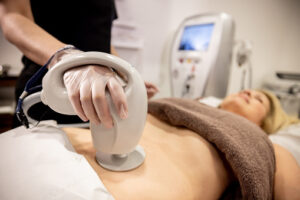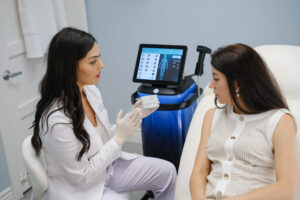There’s no denying it, at-home microneedling is super convenient and much cheaper than professional microneedling. That said, you’ll want to consider the possible risks that could arise alongside its benefits.
Though at times you may experience no side effects at all, the fact is, derma rollers puncture the skin. This can lead to all sorts of issues if not handled in a safe and effective way. Read on and discover all you need to know about the potential problems of derma rolling home treatments. As well as ways you may be able to prevent them…
What Does Microneedling Do?
Before we understand the risks, we need to understand what microneedling devices are and what they’re designed to do. Derma rollers are small, hand-held devices made to roll over the skin. The roller, positioned at the top of the device, has tens of tiny needles measuring anywhere between 0.5mm and 2mm. That said, devices designed and sold for home use are most often only between 0.5mm and 1mm.
So, what do they do and how are they used? To use a derma roller, you’ll need to start with completely clean, dry skin. All makeup and product should be absent ensuring it doesn’t end up being pushed directly into the complexion. The derma roller can then roll over the skin with gentle pressure. You’ll want to concentrate on any areas of concern you have. Most zero in on age lines or any areas with acne scars, for example.
The purpose of this action is to cause slight injury/irritation to the skin. By doing this, you encourage and stimulate collagen production. This results in a more even skin tone and improved texture. It also aids the appearance of fine lines, acne scarring, and sometimes even stretch marks.

Why Are There Risks?
As you would imagine, causing any type of injury to the skin has the potential for problems. Especially considering the skin in question is extremely delicate and therefore more sensitive. It’s for these reasons that home devices, whilst convenient, unfortunately, rarely substitute for a professional appointment.
As much as we wish we were, the majority of us aren’t skin care professionals. For that reason, we can’t be sure of exactly how to carry out professional skincare treatments. Now, this applies to even the most basic procedures. Therefore, those that puncture the skin are trickier to navigate! Injuries and skin damage are much more likely to occur at home for all of the reasons we’re about to explain…
Too Much Pressure
One of the most common mistakes made with at-home microneedling is applying too much pressure. Though we intend to press lightly, it’s easier than you’d think to go in a little too hard. Especially when you’re trying to make a difference to uneven skin. The want for improvement takes over our willpower to press lightly enough not to injure ourselves.
When this happens, the skin retaliates with redness and further signs of extreme irritation. This can show up in the form of blood spots, pimples, and sometimes even scarring too. Not to mention it can damage our sensitive skin longterm if the injuries go too deep regularly.
Risk Of Infection
We should always treat any skin wound, even a microscopic one, with serious care. Unfortunately, the majority of us will not even realize that we’ve injured the skin whilst derma rolling. The needles are so tiny that we can barely feel them. Therefore the damage done is not always immediately apparent. In this case, we’re unable to take the best care of our faces post-procedure. This, unfortunately, can lead to infection. Most often when we puncture the skin but do not clean it properly before or after.
Improper Use Of/ Residue From Skincare Products And Makeup
Before derma rolling, the skin needs to be completely clean and dry. However, this often doesn’t/can not happen at home. Sometimes, it’s because we’ve been neglectful and not washed our faces and device properly, or, at all! Other times, it’s because we don’t have access to the necessary cleaning tools and products that professionals do. We, therefore, can’t know definitively that we’ve completely sterilized everything before beginning!
This is extremely risky when derma rolling at home. Not only could the needles on your device be carrying bacteria, but your skin could be also. Puncturing the skin and allowing any bacteria, dirt, or makeup to enter into its delicate construction will inevitably irritate. This can lead to redness, pimples, and sometimes even infection.

Applying Makeup And Skincare Post Treatment
In addition to not removing skincare products and makeup beforehand, applying them too quickly post-treatment can also be problematic. After creating those micro punctures, some will only wait a short time before applying sunscreen, makeup, etc. Doing this allows them to absorb deep into the skin. This is something we definitely don’t want to happen during the microneedling process.
Why? The ingredients contained within makeup, sunscreen, and some moisturizers, are not suitable for deep skin treatments. Therefore they can easily cause problems for your skin.
How Should Skin Be Cared For Post Treatment?
Whether you’re thinking of microneedling at home or you already have and need to know the best aftercare practices, read on.
You’ll likely be experiencing some form of redness or inflammation even when the treatment is successful. Therefore, a cooling face mask can help to ease irritation and speed up the healing process.
In addition to this, there are certain topical products by Skin Ceuticals that we recommend using post-treatment. We even use them during our own professional microneedling treatments here at the Anushka Spa & Salon!
Both vitamin C serums and hyaluronic acid serums are safe and encouraged for enhanced healing after the microneedling process. Both are highly hydrating, meaning they’ll replenish the skin much quicker avoiding any moisture loss. Meanwhile, your treatment means they’ll absorb much more easily and effectively!










